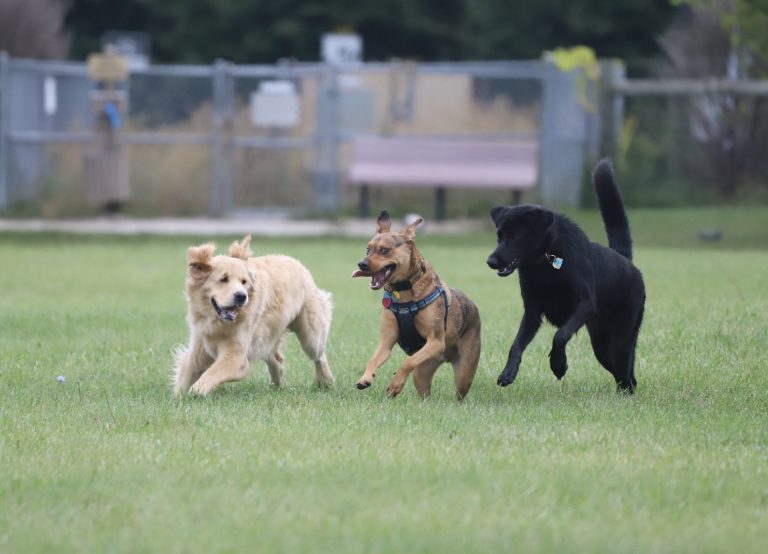Let’s start this article with a statistics study. In 2018, the National Recreation and Park Association ran a survey. The results came and showed 91% of Americans believe dog parks provide benefits to their communities.
The results were even more evident among Generation X and millennials. They looked at the dog park as a beneficial amenity.
There were two reasons why people voted Yes on dogs park as beneficial. More than 60% believed that they provide a safe space and off leash area to exercise your dog. Another 48% believed that dog parks allow dogs to socialize.
Now, these are both true. But there is a dirty little secret nobody tells you about. Not all dogs love the dog park. And there is even something worse. Not all dog owners know how to handle the dog park. So, if you are a dog owner, and you want to know whether the dog park is good for your puppy or not, read on.
Even if you go to a off leash dog area like a park, remember to respect all the dog park rules.
Why are dog parks great?
Let’s start with the obvious. Urban dogs do not have a backyard to exercise in. For a dog owner with an urban dog, dog parks sound like a great idea.
The availability of dog parks is popular among the younger generation. The three top benefits include:
- Gives your dog a safe space to exercise and roam freely
- Allows your puppy to socialize with other dogs
- Allows owners a chance to be physically active with their pet
Debunking the socialization myth
One of the biggest dangers of dog parks is that they do not have separate area enclosures for a large dog and a small dog. When they do, owners usually do not care about it. And while it is important to socialize your puppy with both large and small dogs, you have to do it patiently.
It would be great if there was a large dog area, and a separate area for small dogs. But that is not the case.
Now, another myth is that owners often associate the term socialization with “dogs interacting with other dogs”. But that is not true. Puppy socialization is much more. It is exposing your young puppy to new experiences, new people, and new places.
Exposing your puppy to different novel things allows it to adapt to any new situation. And while socialization is critical for healthy development, the dog park is not the place where you want to socialize your puppy.
Why should you avoid the dog park with a young puppy?
Here is something not many people will tell you. Dog parks are not a safe place to socialize a young puppy under 6 months of age. Why? During the early months of puppyhood, your pup is more sensitive to experiences.
So, a rambunctious greeter at the park may make your puppy uncertain of any dog-dog interaction.
With a young puppy, you want to ensure that it experiences only positive interactions. You want to avoid any overwhelming and frightening situations. And do you think you can have only positive interactions at the dog park?
What can you do instead? Well, instead of taking puppies to a dog park, attend a puppy class with your puppy. There, your young dog will meet age-appropriate playmates. And their play and socialization will be supervised.
Now, socialization with older dogs is a bit more challenging. When you think about it in a behavioral sense, an older dog has had its socialization experiences.
Now, if you are a dog owner, I am sure you mean well and you have a good intention of taking your puppy to the dog park.
But sadly, there are more challenges, obstacles, and dangers lurking there than positive experiences.
The three biggest dangers of the dog park
Before we wrap this thing out, let’s talk about the three dangers lurking in the dog park. Those are playground bullies, injuries, and diseases.
Playground bullies
Yes, dogs are social animals and they engage in various forms of play. But the artificial setup of a dog park can be challenging. Many people WRONGLY bring their dogs there to burn some excess energy. Because they are over-aroused, they might display rude behavior and trigger issues between dogs.
No, that dog might not be bad, but with excess energy, it is looking for ways to spend it. When you are in the dog park, remember, that they are public spaces that are not supervised. Does everyone there monitor their dog? I can bet NO.
You do not want your puppy trying to interact with aggressive dogs, right?
Injuries
This is one of the biggest dangers and challenges of the dog park. Because a dog park doesn’t often have a separate play enclosure for large dogs and small dogs, a large dog can easily injure a smaller dog. Of course, without an intention.
Minor scuffles to serious incidents are common at the dog park. Bite wounds are common as well, especially from rough play.
Diseases
Even a clean dog park can pose health risks in the form of spreading diseases. As an unregulated public space, dog parks do not guarantee every pup is vaccinated. Is there a requirement to show proof of vaccination?
What you shouldn’t do in the dog park?
There are always dog park alternatives. Some include a small field where you can play and train with your dog. Remember, I always say this, your dog doesn’t need other dogs to have fun and play. He has you. And as a responsible dog owner, it is your job to provide exercise and mental stimulation.
Now, here are three things you should not do. Let’s revisit the most important dog park rules:
- Do not go to a dog park without a good recall command
- Do not leave your dog free for all, instead, always pay attention to what your dog is doing and be part of it
- Do not, I repeat, do not EVER come to the dog park with a dog with zoomies. That is a recipe for failure and disaster








2 Responses
I believe the statement, “Do not go to a dog park with a good recall command”, was typo. It meant to say WITHOUT” a good recall. There is absolutely no reason for your dog to interact with strange dogs. There is nothing in a dog park but trouble.
you are absolutely right, thanks for correcting it. That is definitely a typo 🙂